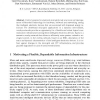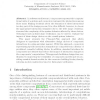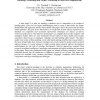ICSE
2007
IEEE-ACM
14 years 11 months ago
2007
IEEE-ACM
Critical infrastructures like the power grid are emerging as collection of existing separated systems of different nature which are interconnected together. Their criticality becom...
ICSE
2007
IEEE-ACM
14 years 11 months ago
2007
IEEE-ACM
Abstract. Control systems for electrical microgrids rely ever more on heterogeneous off-the-shelf technology for hardware, software and networking among the intelligent electronic ...
ICSE
2007
IEEE-ACM
14 years 11 months ago
2007
IEEE-ACM
Abstract. In this chapter we discuss the susceptibility of critical information infrastructures to computer-borne attacks and faults, mainly due to their largely computerized natur...
ICSE
2007
IEEE-ACM
14 years 11 months ago
2007
IEEE-ACM
Abstract. In software architecture, components represent the computational units of a system and connectors represent the interactions among those units. Making decisions about the...
ICSE
2007
IEEE-ACM
14 years 11 months ago
2007
IEEE-ACM
A data model is a plan for building a database and is comparable to an architect's building plans. There are two major methodologies used to create a data model: the EntityRe...
ICSE
2007
IEEE-ACM
14 years 11 months ago
2007
IEEE-ACM
er abstract summarizes the Threat Modeling method based on Attacking Path Analysis (T-MAP) which quantifies and prioritizes security threats by calculating the total severity weig...
ICSE
2007
IEEE-ACM
14 years 11 months ago
2007
IEEE-ACM
Large networks, such as the Internet, pose an ideal medium for solving computationally intensive problems, such as NP-complete problems, yet no well-scaling architecture for Inter...
ICSE
2007
IEEE-ACM
14 years 11 months ago
2007
IEEE-ACM
Many end user programming tools such as spreadsheets and databases offer poor support for representing a level of abstraction that is intuitive to users. For example, users must w...
ICSE
2007
IEEE-ACM
14 years 11 months ago
2007
IEEE-ACM
Policy testing and analysis are important techniques for high assurance of correct specification of access control policies. We propose a set of testing and analysis techniques fo...
ICSE
2007
IEEE-ACM
14 years 11 months ago
2007
IEEE-ACM
Web services are a popular way of implementing a Service-Oriented Architecture. Testing can be used to help assure both the correctness and robustness of a web service. Because ma...




